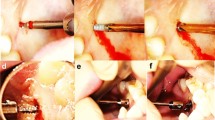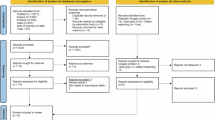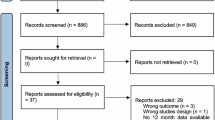Abstract
Data sources Medline, Embase, the Cochrane Oral Health Group's Trials Register, CENTRAL, ClinicalTrials.gov, the National Research Register and Pro-Quest Dissertation Abstracts and Thesis databases.
Study selection Randomised controlled trials (RCTs) non-randomised, or quasi-randomised controlled trials, prospective and retrospective studies involving the assessment of success or failure of palatal implants or palatal mini-screws for orthodontic anchorage reinforcement were considered.
Data extraction and synthesis Two reviewers independently selected the studies, extracted data and assessed risk of bias. A narrative synthesis was presented.
Results Twenty-seven studies (four RCTs, 12 prospective and 11 retrospective studies) were included.
Conclusions No clinically meaningful difference in failure risk seems to exist between palatal implants and mini-screws, however the quality of the available evidence is very low. The studies included between 9 to 384 palatal implants or mini-screws with follow up period ranging from 2 - 35.6 months (median = 17.9). The risk of failure (18 studies) ranged from 0.0 - 26.1% (median 6.0%). The risk of failure in the four RCTS ranged from 2.5 -26.1% (median = 8.8%).
Similar content being viewed by others
Log in or create a free account to read this content
Gain free access to this article, as well as selected content from this journal and more on nature.com
or
References
Kakali L, Alharbi M, Pandis N, Gkantidis N, Kloukos D. Success of palatal implants or mini-screws placed median or paramedian for the reinforcement of anchorage during orthodontic treatment: a systematic review. Eur J Orthod 2018; 41: 9-20.
Shea BJ, Reeves BC, Wells G, et al. AMSTAR 2: a critical appraisal tool for systematic reviews that include randomised or non randomised studies of healthcare interventions, or both. Br Med J 2017; 358: j4008. doi: 10.1136/bmj.j4008.
Risk of bias in systematic reviews (ROBIS). ROBIS tool and the ROBIS guidance document. [online]. Available at http://www.bristol.ac.uk/social-community-medicine/projects/robis/ (accessed January 2019).
Whiting P, Savovic J, Higgins JP. et al; ROBIS group. ROBIS: A new tool to assess risk of bias in systematic reviews was developed. J Clin Epidemiol 2016; 69: 225-234.
Stewart L, Moher D, Shekelle P. Why prospective registration of systematic reviews makes sense. Syst Rev 2012; 1: 7. doi: 10.1186/2046-4053-1-7.
Reynders R, Ronchi L, Bipat S. Mini-implants in orthodontics: a systematic review of the literature. Am J Orthod Dentofacial Orthop 2009; 135: 564.e1-19.
O'Connor D, Green S, Higgins JPT (editors). Chapter 5: Defining the review question and developing criteria for including studies. In: Higgins JPT, Green S (editors). Cochrane Handbook for Systematic Reviews of Interventions Version 5.1.0 (updated March 2011). The Cochrane Collaboration, 2011. [online] Available from: http://handbook-5-1.cochrane.org/ (accessed February 2019).
Higgins JPT, Altman DG, Gøtzsche PC, et al, Cochrane Bias Methods Group, Cochrane Statistical Methods Group. The Cochrane Collaboration's tool for assessing risk of bias in randomised trials. Br Med J 2011; 343: d5928.
Sterne JA, Hernán MA, Reeves BC, et al. ROBINS-I: a tool for assessing risk of bias in non-randomised studies of interventions. Br Med J 2016; 355: i4919.
Bondemark L, Holm AK, Hansen K, et al. Long-term stability of orthodontic treatment and patient satisfaction. A systematic review. Angle Orthod 2007; 77: 181-191.
Schünemann H, Brozek J, Gyatt G, Oxman A, editors. GRADE handbook. Handbook for grading the quality of evidence and the strength of recommendations using the GRADE approach. [updated October 2013]. [online] Available at http://gdt.guidelinedevelopment.org/app/handbook/handbook.html (accessed February 2019).
Author information
Authors and Affiliations
Corresponding author
Rights and permissions
About this article
Cite this article
Reynders, R., Isaia, L. Failure rates of palatal implants or mini-screws for orthodontic anchorage . Evid Based Dent 20, 9–11 (2019). https://doi.org/10.1038/s41432-019-0010-0
Published:
Issue date:
DOI: https://doi.org/10.1038/s41432-019-0010-0



